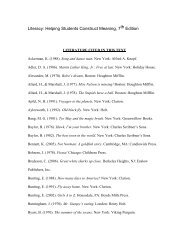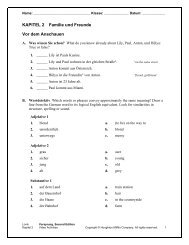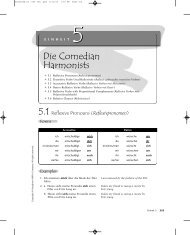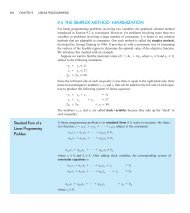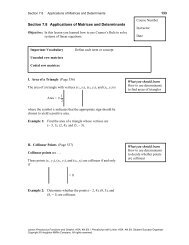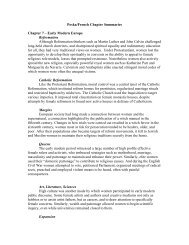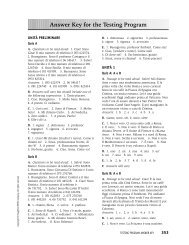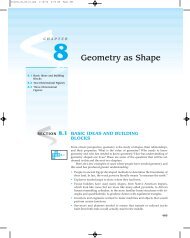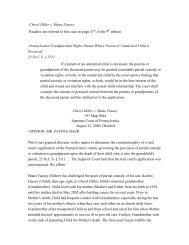Chapter 7: Quantum Theory of the Atom
Chapter 7: Quantum Theory of the Atom
Chapter 7: Quantum Theory of the Atom
You also want an ePaper? Increase the reach of your titles
YUMPU automatically turns print PDFs into web optimized ePapers that Google loves.
56 <strong>Chapter</strong> 7<br />
Solution<br />
Wavelength and frequency are inversely related. Moreover, ultraviolet light is at higher<br />
frequency than yellow light. Doubling <strong>the</strong> frequency <strong>of</strong> a beam <strong>of</strong> light would give that beam<br />
a higher frequency than yellow light, whereas doubling <strong>the</strong> wavelength would give that beam<br />
a lower frequency than yellow light. Consequently, <strong>the</strong> beam with frequency doubled must be<br />
<strong>the</strong> one in <strong>the</strong> ultraviolet region.<br />
Here is ano<strong>the</strong>r way to look at <strong>the</strong> problem. Energy is directly related to <strong>the</strong> frequency<br />
and inversely related to <strong>the</strong> wavelength. Thus, <strong>the</strong> beam whose frequency is doubled will<br />
increase in energy, whereas <strong>the</strong> beam whose wavelength is doubled will decrease in energy.<br />
Since yellow light is in <strong>the</strong> visible region <strong>of</strong> <strong>the</strong> spectrum, which is lower in energy than <strong>the</strong><br />
ultraviolet region (Figure 7.5), <strong>the</strong> beam whose frequency is doubled will be higher in energy<br />
and thus in <strong>the</strong> UV region <strong>of</strong> <strong>the</strong> spectrum.<br />
Conceptual Problem 7.20<br />
Some infrared radiation has a wavelength that is 1000 times larger than that <strong>of</strong> a certain<br />
visible light. This visible light has a frequency that is 1000 times smaller than that <strong>of</strong> some X<br />
radiation. How many times more energy is <strong>the</strong>re in a photon <strong>of</strong> this X radiation than <strong>the</strong>re is<br />
in a photon <strong>of</strong> <strong>the</strong> infrared radiation?<br />
Solution<br />
Frequency is inversely related to <strong>the</strong> wavelength. Thus, <strong>the</strong> infrared radiation with a<br />
wavelength that is one thousand times larger than <strong>the</strong> visible light would have a frequency<br />
one thousand times smaller than <strong>the</strong> visible light. But, <strong>the</strong> visible light has a frequency one<br />
thousand times smaller than that <strong>of</strong> <strong>the</strong> X radiation. This makes <strong>the</strong> frequency <strong>of</strong> <strong>the</strong> X<br />
radiation one million times larger than <strong>the</strong> frequency <strong>of</strong> <strong>the</strong> infrared radiation. Therefore,<br />
since energy is directly related to <strong>the</strong> frequency, <strong>the</strong> energy <strong>of</strong> <strong>the</strong> X radiation would be one<br />
million times as large as <strong>the</strong> energy <strong>of</strong> <strong>the</strong> infrared radiation.<br />
Conceptual Problem 7.21<br />
One photon <strong>of</strong> green light has less than twice <strong>the</strong> energy <strong>of</strong> two photons <strong>of</strong> red light. Consider<br />
two hypo<strong>the</strong>tical experiments. In one experiment, potassium metal is exposed to one photon<br />
<strong>of</strong> green light; in ano<strong>the</strong>r experiment, potassium metal is exposed to two photons <strong>of</strong> red light.<br />
In one <strong>of</strong> <strong>the</strong>se experiments, no electrons are ejected by <strong>the</strong> photoelectric effect (no matter<br />
how many times this experiment is repeated), whereas in <strong>the</strong> o<strong>the</strong>r experiment at least one<br />
electron is ejected. What is <strong>the</strong> maximum number <strong>of</strong> electrons that could be ejected during<br />
this experiment, one or two?




